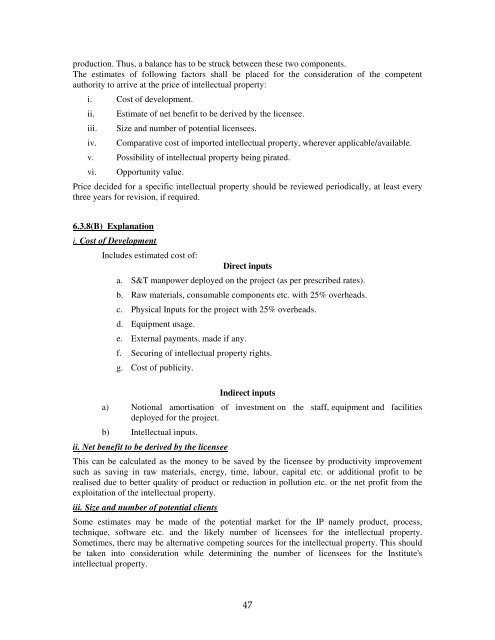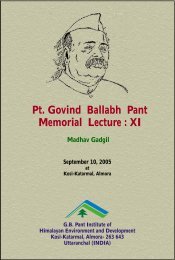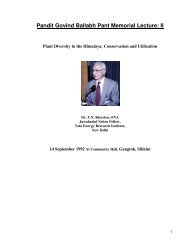rules and regulations of gbpihed - Govind Ballabh Pant Institute of ...
rules and regulations of gbpihed - Govind Ballabh Pant Institute of ...
rules and regulations of gbpihed - Govind Ballabh Pant Institute of ...
You also want an ePaper? Increase the reach of your titles
YUMPU automatically turns print PDFs into web optimized ePapers that Google loves.
production. Thus, a balance has to be struck between these two components.<br />
The estimates <strong>of</strong> following factors shall be placed for the consideration <strong>of</strong> the competent<br />
authority to arrive at the price <strong>of</strong> intellectual property:<br />
i. Cost <strong>of</strong> development.<br />
ii.<br />
iii.<br />
iv.<br />
Estimate <strong>of</strong> net benefit to be derived by the licensee.<br />
Size <strong>and</strong> number <strong>of</strong> potential licensees.<br />
Comparative cost <strong>of</strong> imported intellectual property, wherever applicable/available.<br />
v. Possibility <strong>of</strong> intellectual property being pirated.<br />
vi.<br />
Opportunity value.<br />
Price decided for a specific intellectual property should be reviewed periodically, at least every<br />
three years for revision, if required.<br />
6.3.8(B) Explanation<br />
i. Cost <strong>of</strong> Development<br />
Includes estimated cost <strong>of</strong>:<br />
Direct inputs<br />
a. S&T manpower deployed on the project (as per prescribed rates).<br />
b. Raw materials, consumable components etc. with 25% overheads.<br />
c. Physical Inputs for the project with 25% overheads.<br />
d. Equipment usage.<br />
e. External payments, made if any.<br />
f. Securing <strong>of</strong> intellectual property rights.<br />
g. Cost <strong>of</strong> publicity.<br />
Indirect inputs<br />
a) Notional amortisation <strong>of</strong> investment on the staff, equipment <strong>and</strong> facilities<br />
deployed for the project.<br />
b) Intellectual inputs.<br />
ii. Net benefit to be derived by the licensee<br />
This can be calculated as the money to be saved by the licensee by productivity improvement<br />
such as saving in raw materials, energy, time, labour, capital etc. or additional pr<strong>of</strong>it to be<br />
realised due to better quality <strong>of</strong> product or reduction in pollution etc. or the net pr<strong>of</strong>it from the<br />
exploitation <strong>of</strong> the intellectual property.<br />
iii. Size <strong>and</strong> number <strong>of</strong> potential clients<br />
Some estimates may be made <strong>of</strong> the potential market for the IP namely product, process,<br />
technique, s<strong>of</strong>tware etc. <strong>and</strong> the likely number <strong>of</strong> licensees for the intellectual property.<br />
Sometimes, there may be alternative competing sources for the intellectual property. This should<br />
be taken into consideration while determining the number <strong>of</strong> licensees for the <strong>Institute</strong>'s<br />
intellectual property.<br />
47











